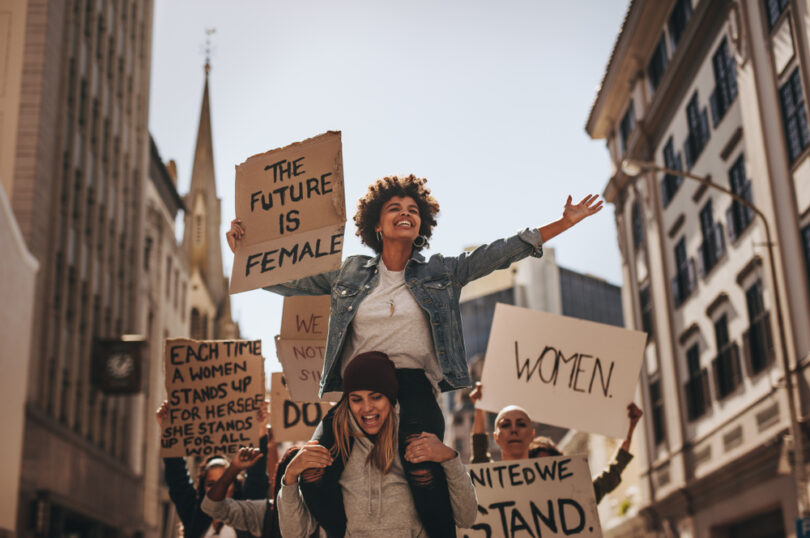Women’s History Month is devoted to celebrating the accomplishments of women across the globe. It’s a time to look back at how far women have come, what they’ve achieved, and how far they still have to go. Women’s History Month is also a time of awareness and activism throughout the nation. And what better way to get involved and educated than by joining in? From marches and rallies to museums and exhibits, we have everything you need to celebrate Women’s History Month in ways you never imagined!

The National Archives — Washington, D.C.
If you’re a history buff, the National Archives are the perfect way to dive into the past. This Washington, D.C. location provides you with an exhaustively in-depth look at women’s role in American history, complete with historical documents and images to help bring the past to life. You can tour the museums, libraries, or even do your own genealogical research! The Archives Museum also typically holds various events and exhibits dedicated to Women’s History Month.
World War II Home Front National Historical Park — Richmond, California
While it’s a beautiful park, the World War II Home Front National Historical Park just outside of San Francisco has a lot more to offer than mere visuals. And, of course, it’s also the proud home to the Rosie the Riveter Memorial. Besides being a testament to the countless women who helped in war efforts during World War II, the memorial also provides people with fascinating facts about the real Rosie and women like her. It’s a unique look at the recent past and a sobering reminder of those who sacrificed so much for peace.

The Metropolitan Museum of Art — New York City
Learn about all the fierce and fabulous women who made their mark in the art world thanks to this very special tour at the Metropolitan Museum of Art. The two-hour tour in New York City gives you an unprecedented look at how women have helped shape modern-day art. From the first female pharaoh who was worshipped as a god in paintings and sculptures to the artists that dared to stand out in the male-dominated field, this tour is an inspiring and insightful view of art you’ve never experienced before.
You May Also Like: 6 Unique Places to Celebrate Black History
Women’s Rights National Historical Park — Seneca Falls, New York
One of the most important sites in New York concerning women’s rights, this historical park is a must-see. The Women’s Rights Historical National Park spans 6.8 acres and can be found among the National Votes for Women Trail — a route that is home to multiple key landmarks centered around women’s history. This trail includes the homes of Elizabeth Cady Stanton and Jane Hunt, who were leaders in the suffragist movement. You can also see Wesleyan Chapel, which is where the first women’s rights convention was held.

Women’s Rights National Historical Park
Clara Barton National Historic Site — Glen Echo, Maryland
If you haven’t heard of Clara Barton, you’re missing out on a fascinating piece of history — and the story of a truly inspiring woman. While she did everything from work in the educational system and the U.S. Patent Office to organizing the distribution of foods and medical supplies to soldiers during the Civil War, she is perhaps best known for founding the American Red Cross.
Fortunately, you can see where Barton got her start. You can celebrate Women’s History Month by visiting the place where it all began. Take the time to wander through the National Historic Site — which is about two miles away from Washington D.C. — that served both as Barton’s home and the birthing place for the American Red Cross. There are a variety of tours there and intriguing historical facts. Clara Barton remains an inspiring example of how one person can inspire major change in the world around them.
FAQs:
Q: When is Women’s History Month celebrated?
A: Women’s History Month is observed every March in the United States. It originated as a weeklong celebration in 1980 and was officially expanded to a full month in 1987.
Q: Are these historic sites free to visit?
A: Many of the sites listed, such as the Women’s Rights National Historical Park and the National Archives Museum, offer free admission. However, some special exhibits or guided tours may have fees. It’s best to check each site’s official website for details.
Q: What should I bring when visiting these landmarks?
A: Comfortable walking shoes are recommended, as some sites involve walking tours. If you’re visiting outdoor locations, bring sunscreen, water, and weather-appropriate clothing. For museums, a notepad or phone for taking notes and photos (where allowed) can be helpful.
Q: Are these sites accessible to visitors with disabilities?
A: Most historical sites and museums strive to be accessible, with ramps, elevators, and accommodations available. However, some older structures may have limited access. Checking with the site beforehand can help ensure a smooth visit.
Q: Can I take guided tours at these locations?
A: Yes, many of these places offer guided tours. Some, like The Metropolitan Museum of Art, provide specialized tours focused on women’s contributions to history and art. Be sure to check availability and whether reservations are required.
Q: Are there virtual options for celebrating Women’s History Month?
A: Yes! Many institutions, including the National Archives, offer online exhibitions, virtual tours, and educational events. These provide great opportunities to celebrate remotely if you can’t visit in person.
Q: How else can I celebrate Women’s History Month?
A: You can attend local events, support women-owned businesses, read books by female authors, watch documentaries about historical women, or donate to organizations that promote women’s rights and education.
How are you going to celebrate Women’s History Month? Tell us about it in our comments section below!








